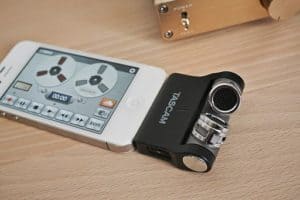
Alright, so you’ve got a band, you’ve got a place to practice, and you’re focused on that big prize—international success, millions of social media followers and ton of royalties from iTunes and Spotify downloads. You’re committed to “making it”! Now all you need to do is polish your act to perfection!
Just like golfers look at their swings in a mirror, just like public speakers rehearse in front of a video camera, just like ballet dancers study and perfect their every move, YOU need to do the same. The answer is simple… you need to RECORD your rehearsals!
How to record your rehearsals?
If you’re anything like I was when I was starting out, your rehearsal space is probably in your drummer’s basement, or in a crumbling old warehouse that’s been sectioned off into dozens of small, loud and dirty rooms.
If you’re lucky you’ve got some rudimentary sound absorption on the walls, like some old carpet or something, but that’s about it. Hearing clearly is a challenge, to say the least.
The good news is, you’re not going for perfection here (at least with the audio quality!). The main purpose is for self-evaluation and improvement.
You want to get a good enough recording so you can hear the parts at least clearly enough to know what everyone is doing, but you are (probably anyway) not going to release these to the masses (although what a fun B-side or fundraiser perk they would make for the hardcore fans!).
So, down to the nuts and bolts (finally!)… How do you go about recording a loud, noisy rehearsal? The answer is, in a variety of different ways! Here are some great examples:
Best Ways to Record
1.Use Your Phone!

 ], via Wikimedia Commons
], via Wikimedia Commons
Probably the most basic way to capture your band’s overall sound is with your phone! Have you ever heard of the KISS Principle? Keep it Simple, Stupid! (I’m not calling you stupid, but they needed another S word haha). Keeping things simple allows you to concentrate on your music and not the technology.
There are several great apps available today that allow you to actually get some pretty decent-sounding recordings (several of which are even free).
From Apple’s Garageband, to StudioMini for Android phones, all you need to do is download the app and away you go. You’re only limited by the storage space on your phone.
For an even better recording, you can consider buying an inexpensive external microphone that interfaces with your phone. Plus you can upload your recorded tracks to your favorite Digital Audio Workstation if you want to edit and work with them further.
2.Use a Field Recorder
A step up from a smartphone recording would be to use a stereo field recorder, which is a handheld device that records to an internal SD card.
A couple of quality makers include Zoom and Tascam, and they not only make great stereo recordings, but they allow easy gain adjustments so your drummer isn’t blowing out the mic.
The SD card can easily be inserted into your laptop so that you can edit and process the tracks in your DAW of choice. This also makes things easy to review—gather your band around the laptop and listen, take notes and improve that performance.
3.Use a Video Recorder with a Stereo Mic
This is another great option as one expense can cover both your audio and video needs. These little handheld guys are great for filming both your rehearsals and your live performances as well, and a lot of them offer ways to upload to Youtube and Facebook directly from the camera, which is really cool if you’re on the road and want to provide new content from that great show the night before to your content-hungry fans.
I love that the gain control allows you to actually capture great sound along with the HD video because nothing is worse than a fan’s recording of a live gig that someone puts online—those look great but sounds like crap! This fixes that problem.
4.Use Your Laptop and an Audio Interface (Recommended One)
This is the next step up the ladder and can be a significant one because you’ve got multiple mic inputs and a full DAW to work with. I’ve had great success here, with a variety of configurations.
A simple two-channel interface like a Focusrite 2i2 will do a smashing job, and you can up the ante from there. If you go the two-mic route, try putting a stereo pair of condenser mics in an X-Y pattern as far away from the drums as you can get, and centered in the room from there.
Or, if you have more inputs (and mics), you can put a close mic on the guitar amp, go direct out of the bass amp, and use multiple mics on the drum kit—try the Recorderman or Glynn Johns methods (just Google them) and see which works best for your situation. Obviously, don’t forget the vocals! Half the fun is experimenting here.
- Exclusive to this Bundle: Waves Musicians 2 with 6 Indispensable Audio Plugins:Renaissance...
- Hitmaker Expansion features exclusive content from legendary Auto-Tune creators Antares, along with...
- Two of the best performing Scarlett mic preamps the range has ever heard – now with Air – for...
Last update on 2025-06-23 / Affiliate links / Images from Amazon Product Advertising API
5.Go Old School and Use a Tape Recorder
Cassette tapes are enjoying a resurgence among the hipster set. While these don’t offer the best sound quality, they are easy enough to “set and forget”. You can get an old tape recorder for pennies these days at a pawn shop or a flea market (or likely even for free!), and 120-minute cassettes can still be found if you look hard enough.
That’s an hour a side to record your free jams and ideas—just set it and forget it! If you DO go this (admittedly VERY budget) route, I’d recommend finding a tape recorder with an adjustable mic level control; otherwise, you’re likely to overload the inputs the first time the drummer bashes his or her snare.
6.Another Old School Trick… Use a Portable Multitrack Recorder
Cassette-based recording isn’t limited to just using a tape recorder. Many people (myself included) made their first multitrack recordings using a handy little portable studio rig—these little guys (Fostex and Tascam made the most popular models; the Tascam one was called the “Portastudio”) allowed you to record four tracks at a time on to a cassette tape. Then came the eight track models, and then 16…. and so on.
If tape isn’t your thing, there is still a portable stand-alone solution for you of course! The digital models record directly to hard disk, and used ones can be found for around $100.
Record Using a Laptop and an Interface (a Sample Setup)
As technology has become readily available and affordable, it’s safe to assume that many bands have access to a simple computer-based recording setup. At its heart, that is most likely going to be a laptop and a small audio interface (“small” meaning with two to four inputs).
Pay close attention, absolute beginners, this section is for you!
In a nutshell, your signal chain goes from your microphone, into your interface, and is then sent into your laptop, where a Digital Audio Workstation (DAW) application can be used to record and then manipulate the sounds.
As you’re starting from scratch, let’s assume you have access to one microphone to be used to record your rehearsal (and it really doesn’t matter what kind of mic that is—as long as it can be plugged into your interface with an XLR-type connection, it will work for our purposes).
Check out which is better between an XLR vs. TRS for a recording studio here!
Step 1. Connect your mic to your interface using an XLR cable. Put your mic on a stand, somewhere in the corner of your rehearsal room, as far from the drummer (and ideally amplifiers) as possible.
It really doesn’t matter which you use; they all have basically the same capacity to manipulate recorded sound and will do a great job. It’s up to you to find one you feel comfortable using, like the workflow of, etc.).
Make sure the output of that track is set to the main outputs of your interface.
As this is happening, look at the input level coming into your DAW. Ideally you want a good healthy signal, but you don’t want it to “clip” or show red.
Aim for the meter to be going about two-thirds the way up the meter strip. The numbers should be between -24 and -12db. If you need to adjust this level, don’t use the fader in your daw—use the input knob on your interface.
Step 7. Once everything is set up and operating, and confirmed by your test recording, it’s time to get to work! Play through a song and listen back. See how it sounds!
Step 8. Expand your setup by using additional mics, if you have access to them. Try different mic placement locations to improve the sound. Move the mics, make a test recording and repeat the process until you get a useable, satisfactory recording.
Learn from your experience and have fun!
Benefits to Recording Your Rehearsals Often
These are some of the benefits :
1.Recording and evaluating your rehearsals are key parts of your band’s development and will allow you to both track your progress and fix issues. Think of it this way – it’s a chance for you to grade your performance before an audience does it for you!
2. You can capture any fleeting magic if it should occur! If you’ve got “tape” always “rolling” during a free jam, you can be safe in the knowledge that all those great riffs are being recorded, and later on you can come back, listen to what you’ve got and work them into full-fledged songs.
3. As in any creative or athletic endeavor, paying attention to the finer points and practicing over and over are crucial components to looking and sounding professional with your band.
4. You don’t want to practice the WRONG things or get into bad habits, so regularly reviewing what you look and sound like is a good idea. Is your bass player late on his cue in the intro? Is your voice out of tune in that one section? Are your tempos rushed?
5. Knowing, discussing and correcting issues like the above will make all the difference between being polished and being amateurs.
Tips and Tricks
Recording is definitely more of an art than a science, and usually, the answer to any kind of “how do I…” question is, “it depends”.
That can be frustrating, but it’s also freeing in a way because it means they’re usually more than one solution to a problem and no wrong way to do something.
There are some tips and tricks in the previous sections, but here are a few more that will help you get some great recordings of your band’s rehearsals:
These don’t need to be pretty. Old blankets or quilts draped over chairs or a mic stand set like a “T” can go a long way towards preventing one mic’s intended recording source from bleeding into another, and your recordings will improve as a result.
The pros all know how to play with feeling at any volume, and you will benefit from keeping that in mind, too. Have your drummer play with rods or brushes if they are so loud they’re blowing off the doors off the place.
Now What?
Eventually, you can even work up to implementing a full studio set-up in your rehearsals. Nothing is cooler than rehearsing in a “real” studio, where everyone is isolated sonically, everything is mic’ed up, and you’ve all got your own headphone mixes.
It’s almost like listening to an album while you play along, and it can be amazing what potential mistakes that clarity will help you to hear and thus fix. It’s a lot easier to identify problem areas when you can hear them!
There’s a solution to fit every budget here, and with an amazing array of technology, recording your band’s rehearsals is easier than ever. Don’t pass up this opportunity to really hear yourself, evaluate what you’re doing and improve! Your fans will thank you.

Author: Adam Coolong has been playing with his band Wild Colonial Bhoys full-time for over fifteen years and has recorded dozens of albums through his studio business, Varsity Audio Recording Services.
Recent Posts
QuickTime is a vital app for many Mac users, and if you’ve recently bought a new microphone, you might wonder how to use it optimally. QuickTime cannot record audio content if it doesn’t have...
Every microphone leaves a unique signature on the quality of its output. If you’re a podcaster trying to melt your way into your audience’s hearts, a muddy, distorted recording won’t cut it....

